问题描述:用逻辑回归根据学生的考试成绩来判断该学生是否可以入学
这里的训练数据(training instance)是学生的两次考试成绩,以及TA是否能够入学的决定(y=0表示成绩不合格,不予录取;y=1表示录取)
因此,需要根据trainging set 训练出一个classification model。然后,拿着这个classification model 来评估新学生能否入学。
训练数据的成绩样例如下:第一列表示第一次考试成绩,第二列表示第二次考试成绩,第三列表示入学结果(0--不能入学,1--可以入学)
34.62365962451697, 78.0246928153624, 0 30.28671076822607, 43.89499752400101, 0 35.84740876993872, 72.90219802708364, 0 60.18259938620976, 86.30855209546826, 1 .... .... ....
训练数据图形表示 如下:橫坐标是第一次考试的成绩,纵坐标是第二次考试的成绩,右上角的 + 表示允许入学,圆圈表示不允许入学。
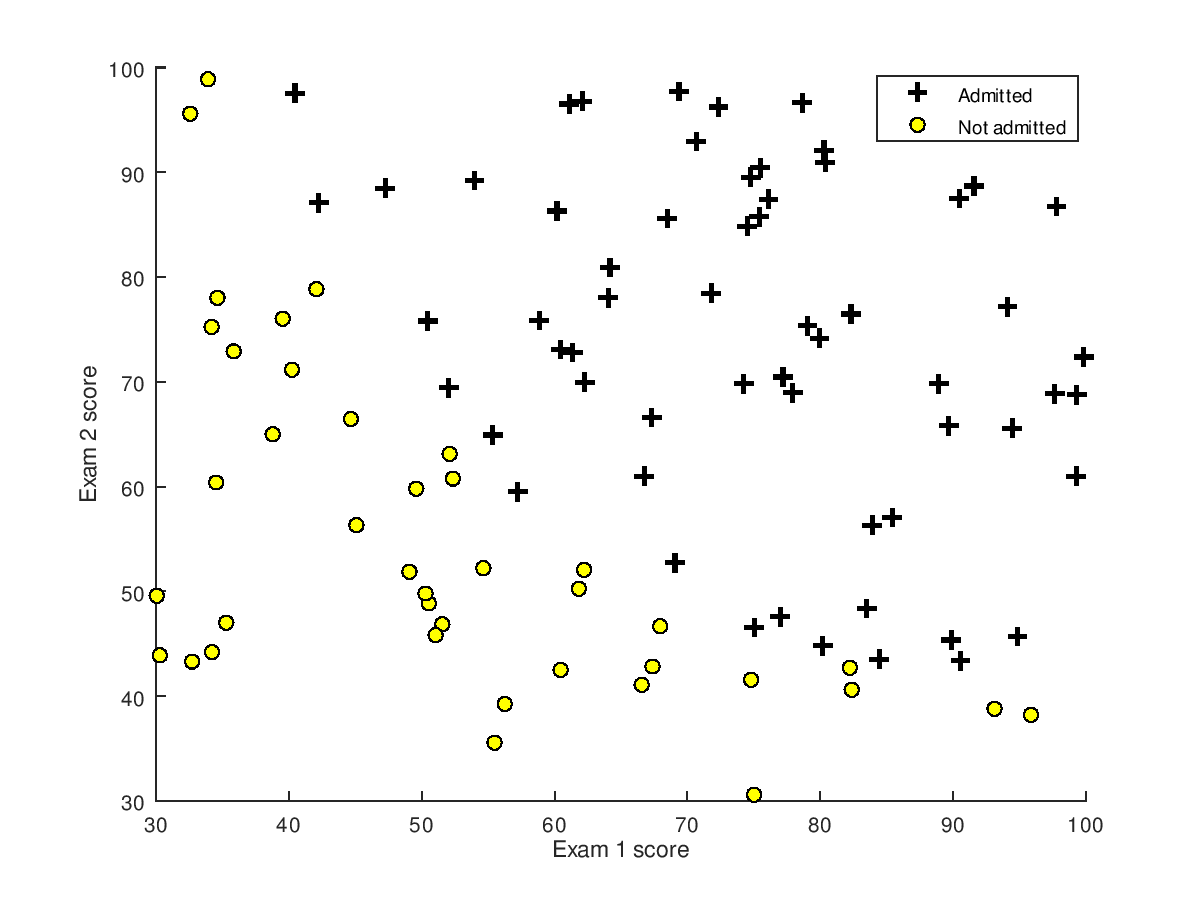
该训练数据的图形 可以通过Octave plotData函数画出来,它调用Octave中的plot函数和find函数,实现如下:
function plotData(X, y) %PLOTDATA Plots the data points X and y into a new figure % PLOTDATA(x,y) plots the data points with + for the positive examples % and o for the negative examples. X is assumed to be a Mx2 matrix. % Create New Figure figure; hold on; % ====================== YOUR CODE HERE ====================== % Instructions: Plot the positive and negative examples on a % 2D plot, using the option 'k+' for the positive % examples and 'ko' for the negative examples. % pos = find(y==1); neg = find(y==0); plot(X(pos, 1), X(pos, 2), 'k+', 'LineWidth', 2, 'MarkerSize', 7); plot(X(neg, 1), X(neg, 2), 'ko', 'MarkerFaceColor', 'y', 'MarkerSize', 7); % ========================================================================= hold off; end
加载数据:
>> data = load('ex2data1.txt');
>> X = data(:, [1, 2]); y = data(:, 3);
加载完数据之后,执行以下代码(调用自定义的plotData函数),将图形画出来
>> plotData(X,y);
>> hold on
>> xlabel('Exam 1 score')
>> ylabel('Exam 2 score')
>> legend('Admitted', 'Not admitted')
图形画出来之后,对训练数据就有了一个大体的可视化的认识了。接下来就要实现 模型了,这里需要训练一个逻辑回归模型。
①sigmoid function
对于 logistic regression而言,它针对的是 classification problem。这里只讨论二分类问题,比如上面的“根据成绩入学”,结果只有两种:y==0时,成绩未合格,不予入学;y==1时,可入学。即,y的输出要么是0,要么是1
如果采用 linear regression(线性回归),它的假设函数是这样的:
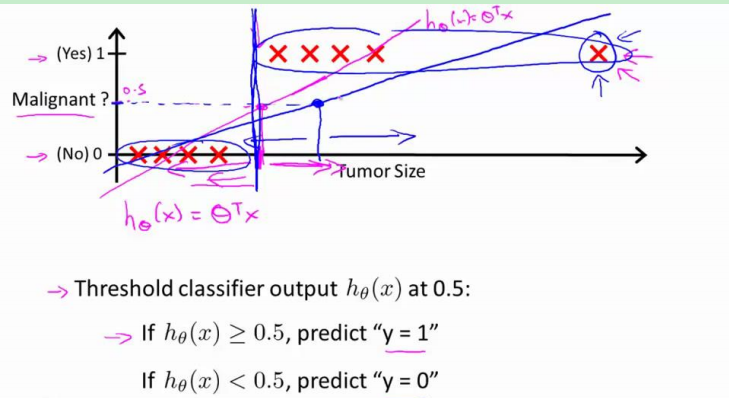
假设函数的取值即可以远远大于1,也可以远远小于0,并且容易受到一些特殊样本的影响。比如在上图中,就只能约定:当假设函数大于等于0.5时;预测y==1,小于0.5时,预测y==0。
而如果引入了sigmoid function,就可以把假设函数的值域“约束”在[0, 1]之间。总之,引入sigmoid function,就能够更好的拟合分类问题中的数据,即从这个角度看:regression model 比 linear model 更合适 classification problem.
引入sigmoid后,假设函数如下:
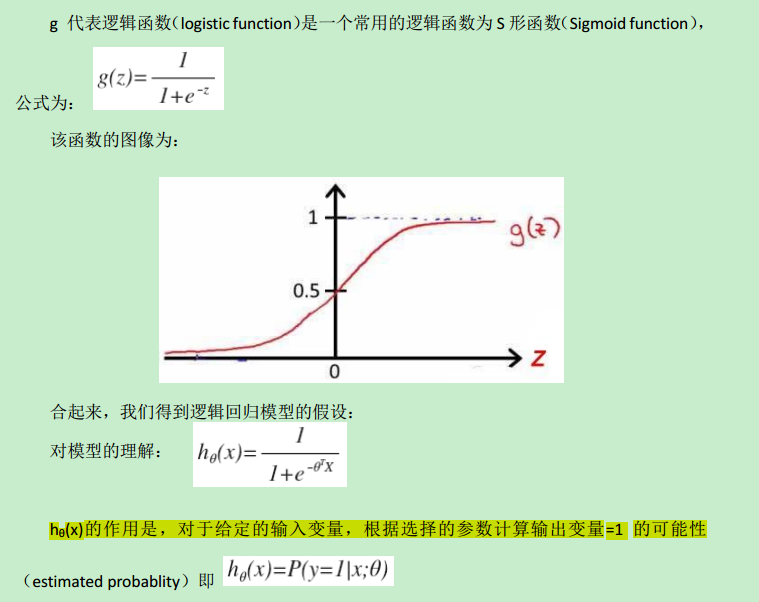
sigmoid function 用octave实现如下:
function g = sigmoid(z) %SIGMOID Compute sigmoid function % g = SIGMOID(z) computes the sigmoid of z. % You need to return the following variables correctly g = zeros(size(z)); % ====================== YOUR CODE HERE ====================== % Instructions: Compute the sigmoid of each value of z (z can be a matrix, % vector or scalar). g=1./(ones(size(z))+exp(-z));%实现sigmoid函数 % ============================================================= end
②模型的代价函数(cost function)
什么是代价函数呢?
把训练好的模型对新数据进行预测,那预测结果有好有坏。因此,就用cost function 来衡量预测的"准确性"。cost function越小,表示测的越准。这里的代价函数的本质是”最小二乘法“---ordinary least squares
代价函数的最原始的定义是下面的这个公式:可见,它是关于 theta 的函数。(X,y 是已知的,由training set 中的数据确定了)

那如何求解 cost function的参数 theta,从而确定J(theta)呢?有两种方法:一种是梯度下降算法(Gradient descent),另一种是正规方程(Normal Equation),本文只讨论Gradient descent。
而梯度下降算法,本质上是求导数(偏导数),或者说是:方向导数。方向导数所代表的方向--梯度方向,下降得最快。
而我们知道,对于某些图形所代表的函数,它可能有很多个导数为0的点,这类函数称为非凸函数(non-convex function);而某些函数,它只有一个全局唯一的导数为0的点,称为 convex function,比如下图:
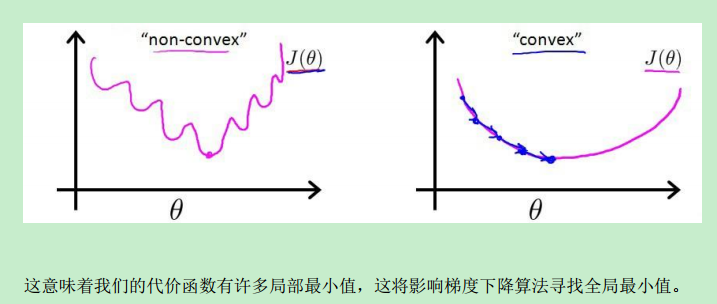
convex function能够很好地让Gradient descent寻找全局最小值。而上图左边的non-convex就不太适用Gradient descent了。
就是因为上面这个原因,logistic regression 的 cost function被改写成了下面这个公式:
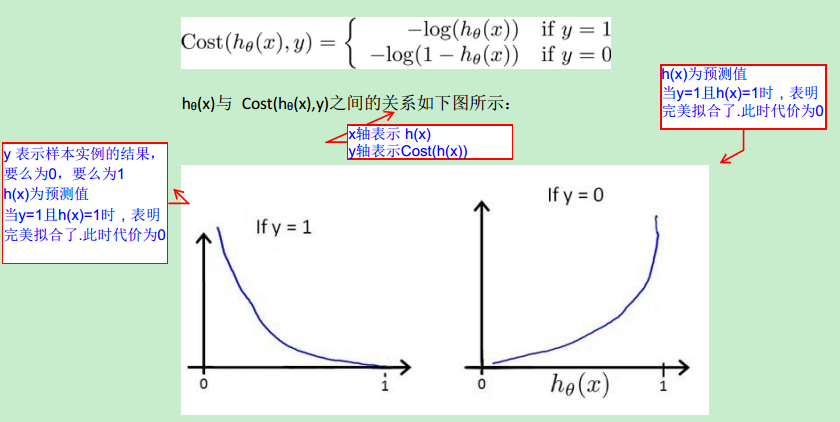
可以看出,引入log 函数(对数函数),让non-convex function 变成了 convex function
再精简一下cost function,其实它可以表示成

J(theta)可用向量表示成:

Octave代码如下:
J=(log(sigmoid(theta'*x'))+log(1-sigmoid(theta'*x’))*(1-y))*(-1/m);
③梯度下降算法
上面已经讲到梯度下降算法本质上是求偏导数,目标就是寻找theta,使得 cost function J(theta)最小。公式如下:

上面对theta(j)求偏导数,得到的值就是梯度j,记为:grad(j)
通过线性代数中的矩阵乘法以及向量的乘法规则,可以将梯度grad表示成向量的形式:
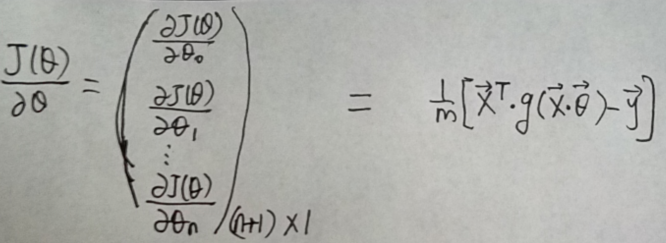
Octave中的实现如下:
grad =(X'*sigmoid(X*theta)-y);
需要注意的是:对于logistic regression,假设函数h(x)=g(z),即它引入了sigmoid function.
最终,Octave中costfunction.m如下:
function [J, grad] = costFunction(theta, X, y) %COSTFUNCTION Compute cost and gradient for logistic regression % J = COSTFUNCTION(theta, X, y) computes the cost of using theta as the % parameter for logistic regression and the gradient of the cost % w.r.t. to the parameters. % Initialize some useful values m = length(y); % number of training examples % You need to return the following variables correctly J = 0; grad = zeros(size(theta)); % ====================== YOUR CODE HERE ====================== % Instructions: Compute the cost of a particular choice of theta. % You should set J to the cost. % Compute the partial derivatives and set grad to the partial % derivatives of the cost w.r.t. each parameter in theta % % Note: grad should have the same dimensions as theta % J=(log(sigmoid(theta'*X'))+log(1-sigmoid(theta'*X’))*(1-y))*(-1/m); grad =(X'*sigmoid(X*theta)-y); % ============================================================= end
通过调用coustFunction函数,从而运行梯度下降算法找到使代价函数J(theta)最小化的 逻辑回归模型参数theta。调用costFunction函数的代码如下:
>> [m, n] = size(X);
>>
>> % Add intercept term to x and X_test
>> X = [ones(m, 1) X];
>> test_theta = [-24; 0.2; 0.2];
>> [cost, grad] = costFunction(test_theta, X, y);
>> cost
cost = 0.21833
>> options = optimset('GradObj', 'on', 'MaxIter', 400);
>>
>> % Run fminunc to obtain the optimal theta
>> % This function will return theta and the cost
>> [theta, cost] = ...
fminunc(@(t)(costFunction(t, X, y)), initial_theta, options);
error: costFunction: operator *: nonconformant arguments (op1 is 1x5, op2 is 3x100)
error: called from
costFunction at line 23 column 3
@<anonymous> at line 4 column 14
fminunc at line 161 column 8
>> [theta, cost] = ...
fminunc(@(t)(costFunction(t, X, y)), test_theta, options);
>> theta
theta =
-25.16126
0.20623
0.20147
>> plotDecisionBoundary(theta, X, y);
>> hold on;
>> % Labels and Legend
>> xlabel('Exam 1 score')theta
parse error:
syntax error
>>> xlabel('Exam 1 score')theta
^
>> ylabel('Exam 2 score')
>>
>> % Specified in plot order
>> legend('Admitted', 'Not admitted')
从上面代码的最后一行可以看出,我们是通过 fminunc 调用 costFunction函数,来求得 theta的,而不是自己使用 Gradient descent 在for 循环求导来计算 theta。for循环中求导计算theta.
既然已经通过Gradient descent算法求得了theta,将theta代入到假设函数中,就得到了 logistic regression model,用图形表示如下:
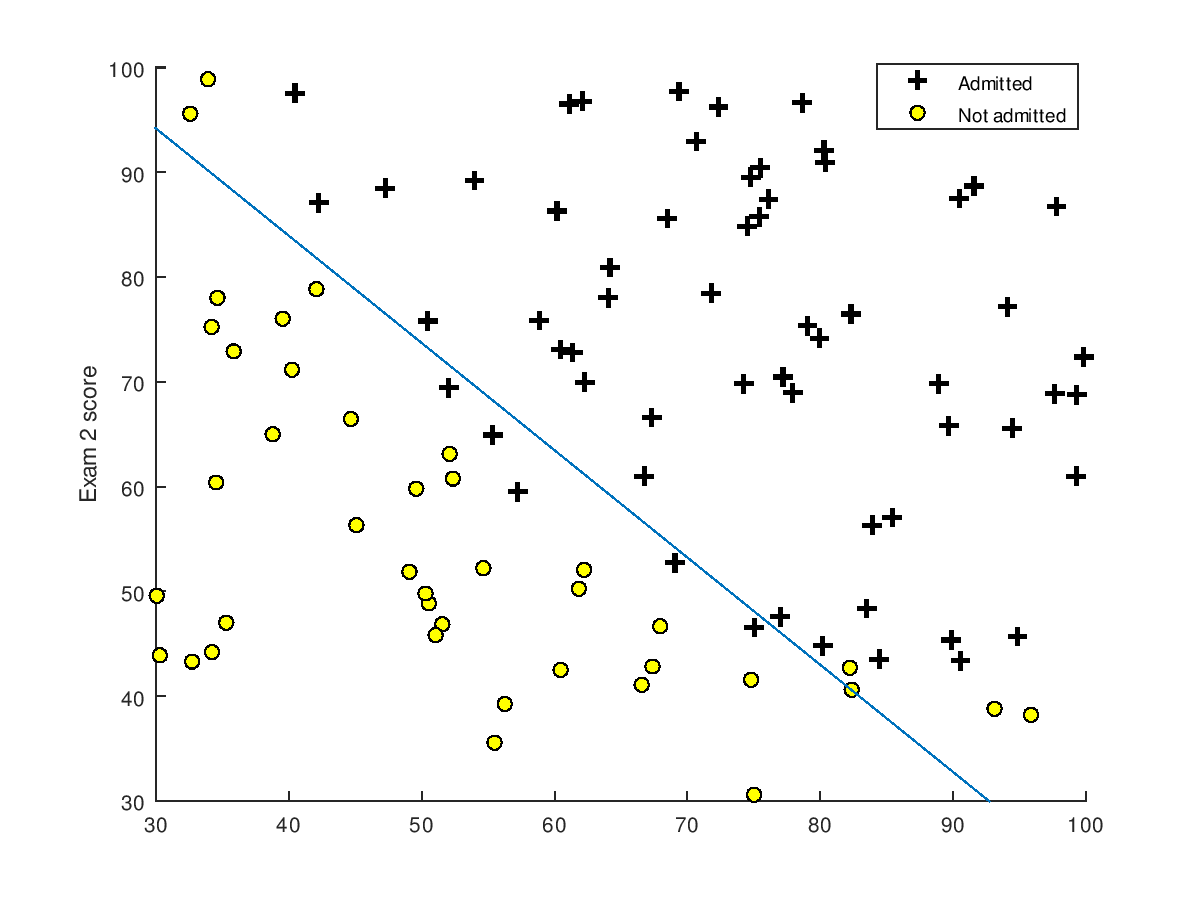
④模型的评估(Evaluating logistic regression)
那如何估计,求得的逻辑回归模型是好还是坏呢?预测效果怎么样?因此,就需要拿一组数据测试一下,测试代码如下:
>> prob = sigmoid([1 45 85] * theta);//%这是一组测试数据,第一次考试成绩为45,第二次成绩为85 >> prob prob = 0.77629
>> p = predict(theta, X);
>> mean(double(p == y)) * 100
ans = 89
那predict函数是如何实现的呢?predict.m 如下:
function p = predict(theta, X) %PREDICT Predict whether the label is 0 or 1 using learned logistic %regression parameters theta % p = PREDICT(theta, X) computes the predictions for X using a % threshold at 0.5 (i.e., if sigmoid(theta'*x) >= 0.5, predict 1) m = size(X, 1); % Number of training examples % You need to return the following variables correctly p = zeros(m, 1); % ====================== YOUR CODE HERE ====================== % Instructions: Complete the following code to make predictions using % your learned logistic regression parameters. % You should set p to a vector of 0's and 1's % p = X*theta >= 0; % ========================================================================= end
非常简单,只有一行代码:p = X * theta >= 0,原理如下:
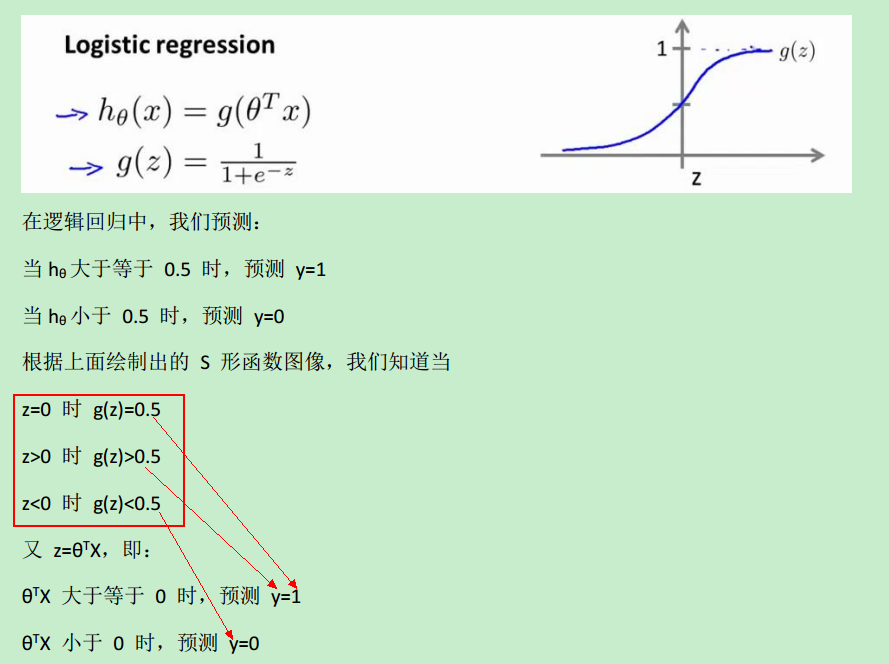
当h(x)>=0.5时,预测y==1,而h(x)>=0.5 等价于 z>=0
⑤逻辑回归的正则化(Regularized logistic regression)
为什么需要正则化?正则化就是为了解决过拟合问题(overfitting problem)。那什么又是过拟合问题呢?
一般而言,当模型的特征(feature variables)非常多,而训练的样本数目(training set)又比较少的时候,训练得到的假设函数(hypothesis function)能够非常好地匹配training set中的数据,此时的代价函数几乎为0。下图中最右边的那个模型 就是一个过拟合的模型。

所谓过拟合,从图形上看就是:假设函数曲线完美地通过中样本中的每一个点。也许有人会说:这不正是最完美的模型吗?它完美地匹配了traing set中的每一个样本呀!
过拟合模型不好的原因是:尽管它能完美匹配traing set中的每一个样本,但它不能很好地对未知的 (新样本实例)input instance 进行预测呀!通俗地讲,就是过拟合模型的预测能力差。
因此,正则化(regularization)就出马了。
前面提到,正是因为 feature variable非常多,导致 hypothesis function 的幂次很高,hypothesis function变得很复杂(弯弯曲曲的),从而通过穿过每一个样本点(完美匹配每个样本)。如果添加一个"正则化项",减少 高幂次的特征变量的影响,那 hypothesis function不就变得平滑了吗?
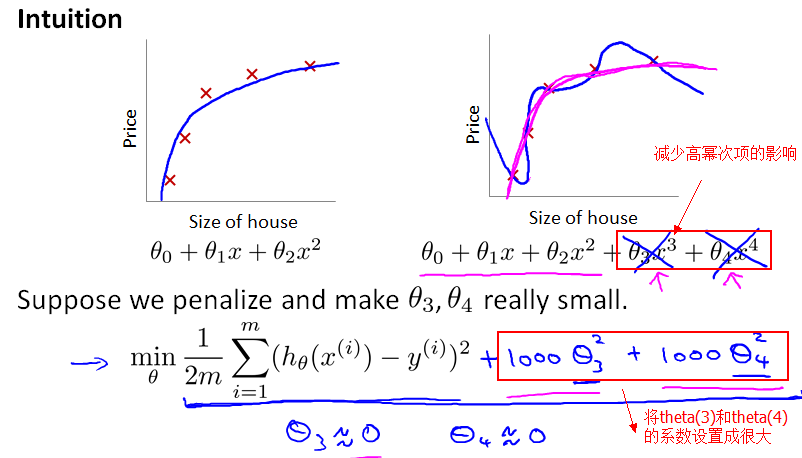
正如前面提到,梯度下降算法的目标是最小化cost function,而现在把 theta(3) 和 theta(4)的系数设置为1000,设得很大,求偏导数时,相应地得到的theta(3) 和 theta(4) 就都约等于0了。
更一般地,我们对每一个theta(j),j>=1,进行正则化,就得到了一个如下的代价函数:其中的 lambda(λ)就称为正则化参数(regularization parameter)
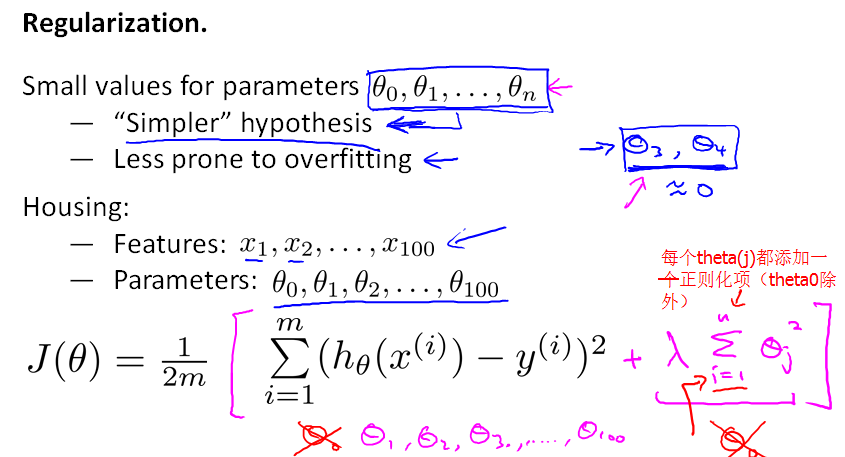
从上面的J(theta)可以看出:如果lambda(λ)=0,则表示没有使用正则化;如果lambda(λ)过大,使得模型的各个参数都变得很小,导致h(x)=theta(0),从而造成欠拟合;如果lambda(λ)很小,则未充分起到正则化的效果。因此,lambda(λ)的值要合适。
最后,我们来看一个实际的过拟合的示例,原始的训练数据如下图:
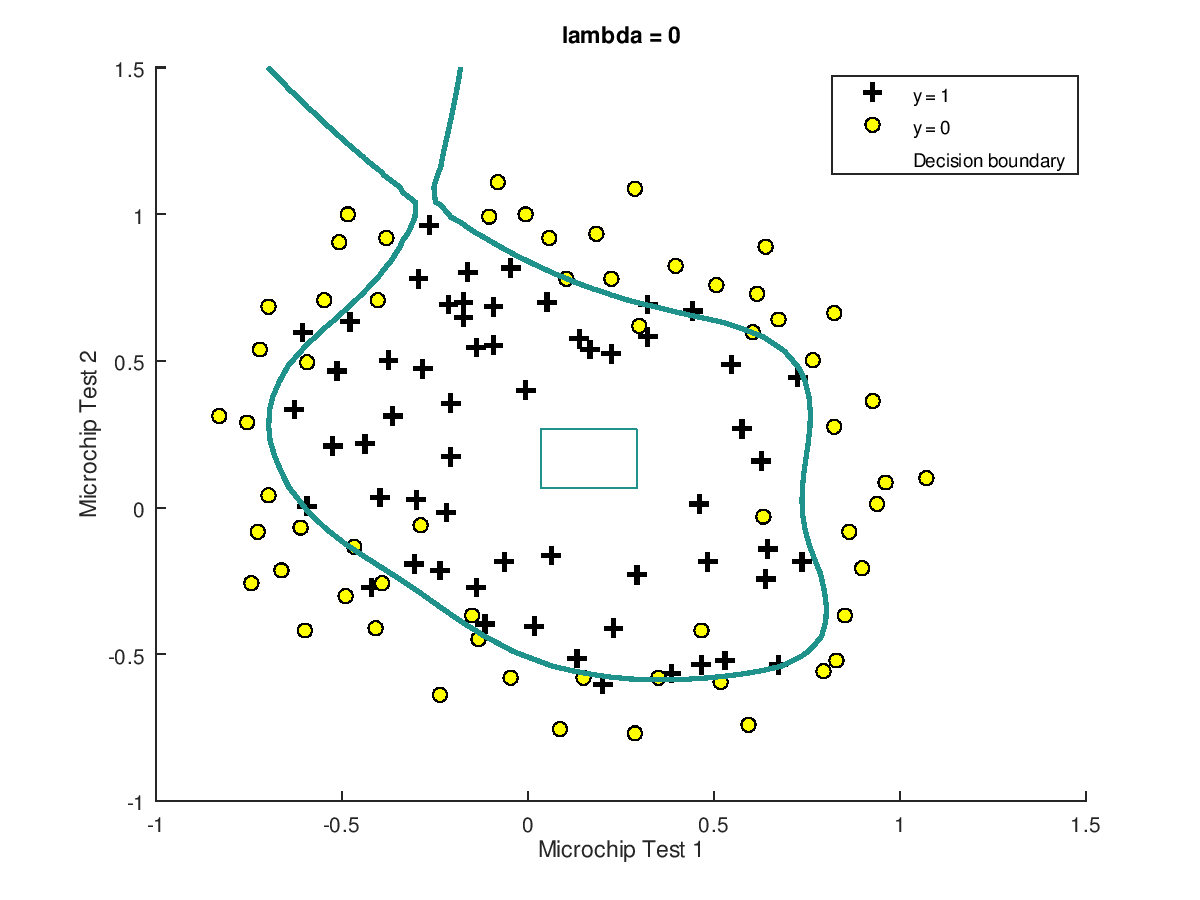
正则化的结果如下图所示:
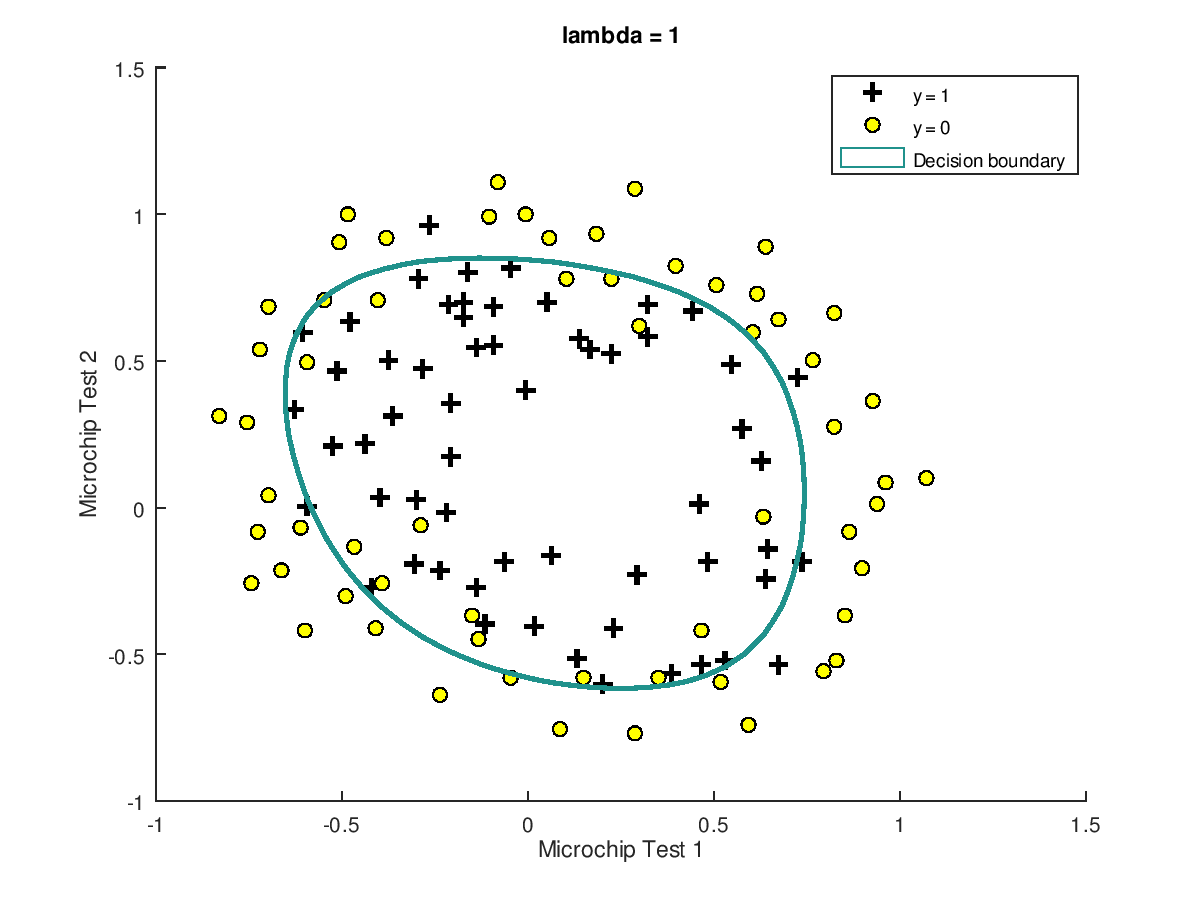
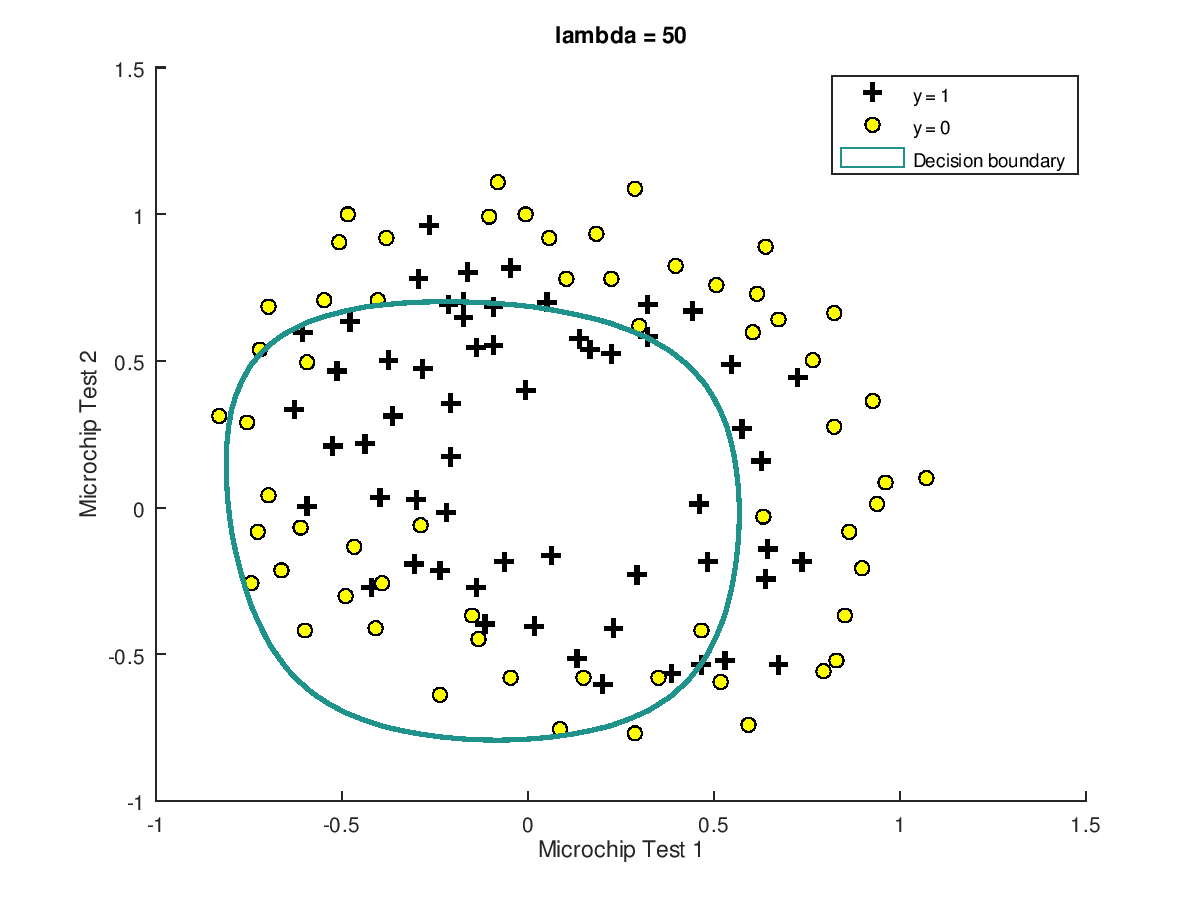
Octave正则化代价函数的实现文件costFunctionReg.m如下:
function [J, grad] = costFunctionReg(theta, X, y, lambda) %COSTFUNCTIONREG Compute cost and gradient for logistic regression with regularization % J = COSTFUNCTIONREG(theta, X, y, lambda) computes the cost of using % theta as the parameter for regularized logistic regression and the % gradient of the cost w.r.t. to the parameters. % Initialize some useful values m = length(y); % number of training examples % You need to return the following variables correctly J = 0; grad = zeros(size(theta)); % ====================== YOUR CODE HERE ====================== % Instructions: Compute the cost of a particular choice of theta. % You should set J to the cost. % Compute the partial derivatives and set grad to the partial % derivatives of the cost w.r.t. each parameter in theta J = ( log( sigmoid(theta'*X') ) * y + log( 1-sigmoid(theta'*X') ) * (1 - y) )/(-m) + (lambda / (2*m)) * ( ( theta( 2:length(theta) ) )' * theta(2:length(theta)) ); grad = ( X' * ( sigmoid(X*theta)-y ) )/m + ( lambda / m ) * ( [0; ones( length(theta) - 1 , 1 )].*theta ); % ============================================================= end
调用代码如下:
>> initial_theta = zeros(size(X, 2), 1);
>>
>> % Set regularization parameter lambda to 1 (you should vary this)
>> lambda = 1;
>> lamdda=0;
>> lambda=1;
>> lambda
lambda = 1
>> lambda=0;
>> lambda
lambda = 0
>> options = optimset('GradObj', 'on', 'MaxIter', 400);
>>
>> % Optimize
>> [theta, J, exit_flag] = ...
fminunc(@(t)(costFunctionReg(t, X, y, lambda)), initial_theta, options);
>>
>> % Plot Boundary
>> plotDecisionBoundary(theta, X, y);
>> hold on;
>> title(sprintf('lambda = %g', lambda))
>>
>> % Labels and Legend
>> xlabel('Microchip Test 1')
>> ylabel('Microchip Test 2')
>>
>> legend('y = 1', 'y = 0', 'Decision boundary')
>> hold off;
>>
>> % Compute accuracy on our training set
>> p = predict(theta, X);
>>
>> fprintf('Train Accuracy: %f
', mean(double(p == y)) * 100);
Train Accuracy: 86.440678